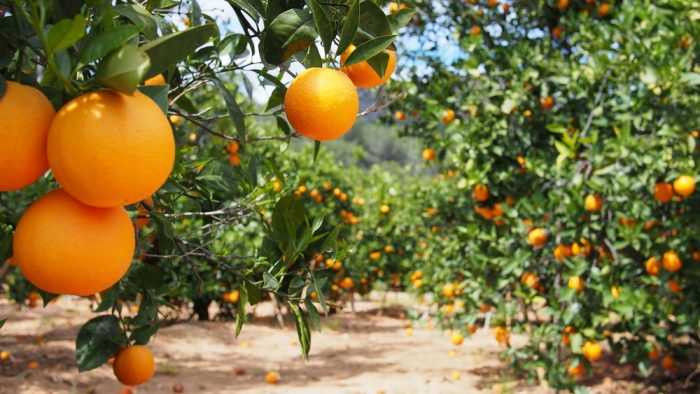Table of Contents
1. Vanilla Fruit
2. Velvet Tamarind
3. Victoria Plum
4. Velvet Apple Fruit
When mature, the flesh will be white to off-white and crumbly but soften over time as it ripens. Described as sweet and fruity while containing hints of chewy bubblegum, the taste is akin to banana-flavored apples or strawberry-mango yogurt. Most people think that darker-colored fruits are sweeter than lighter ones.
Most often, velvet apples are consumed raw. The flesh is scooped from the halved fruit after the fruit is split in half. You can slice or quarter fruits, garnish them with Lemon or lime juice, then serve. You can prepare salads or desserts with the flesh of this tropical fruit. You can puree the flesh and use it for desserts or beverages. You can preserve velvet apples by drying them.
5. Valencia Orange

The Valencia orange (Citrus sinensis) is sweet with a smooth, bright yellow, and shiny skin. It is most commonly used to make marmalade, jelly, and for its juice.
The Valencia orange bears its name after Valencia, Spain, where it originated.
Valencia oranges, also called the summer orange, have at least fifty varieties and hybrids. Among the most popular varieties of orange, this orange is enjoyed by millions worldwide. Valencia oranges ripen in the summer. They are the only oranges that become ripe late in the year.
6. Vaccarese Grape
Perhaps the most well-known application of vacarese is its use in blending Chateauneuf du Pape red wines. Known as Brun Argente, the dark-skinned berry originated in France. Brun Argente is the French word for brown, which describes the grape’s skin and leaves, a brownish color.
Grapes from the Vaccarese variety grow in large bunches that are compact in shape. Because of the size and shape of the berries, it becomes difficult for the bunches to get any air, which can result in rot or botrytis. In the Southern Rhone Valley, the grape continues to become less popular. Châteauneuf du Pape consists of barely four hectares of vines today. One of the few domains to continue using Vaccarese in the blend is Clos St. Jean.
Vaccarese adds little color depth to a blend when added. Instead, it gives the wine a spicy, peppery character and a somewhat tannic structure. The grape is also grown in the Cotes du Rhone region, where Rose’s wines originate.
7. Valencia Pride Mango

Valencia Pride Mango is a quality variety in the mid-late season because of its high yield and relative reliability. Descended from the Haden mango, it emerged in South Florida in the early 1940s. Its fruit is delicious, juicy, and sweet. The tropical flavor is very aromatic, and the consistency is smooth, creamy, almost fiber-free.
This mango tree proliferates and is part of the fastest-growing mango tree varieties in Florida. They can reach a height of over 50 feet with an open and spreading canopy.
8. Van Dyke Mango
Also originally from Florida, the Van Dyke mango variety produces high yields and is highly productive. In appearance, Van Dyke mangoes are oval, with rounded bases and bluntly pointed ends. The lateral beak is generally small on Van Dyke mangoes. An average Van Dyke mango weighs 280 grams and is small to medium in size.
This mango has a beautiful yellow ground color, a prominent beak, and a heavy blush of crimson. Van Dyke mangoes measure approximately 10.5cm long and 7.9cm wide on average. There are several varieties of Van Dyke mangos, and each has thick skin with many white/yellow lenticels.
9. Vernaccia Grape
Vernaccia grapes, which produce the Vernaccia wines, are grown in the hills around Oristano in Sardinia. They are used to make a still, mildly aromatic, sometimes sparkling wine called Vernaccia di Oristano.
10. Volkamer Lemon

According to some citrus specialists, Volkamer Lemons are hybrids between the Lemon and sour oranges, but others believe they are a variety of mandarin lime. Known for more than three centuries, the Volkamer Lemon is acidic and slightly bitter with a pleasant fragrance and flavor.
Italian lemon cultivars have been using Volkamer as a rootstock for years. As a lower acid alternative to the rough Lemon.
Summary
There you have it; our carefully selected list of fruits that start with V. These fruits are nutritious and can contribute significantly to your diet. Also, if you have just read this article four of curiosity, you know a lot about the letter V and the fruits that start with this letter now.
We hope you found the information helpful. Let us know if you have any further questions on the fruits in this list.
